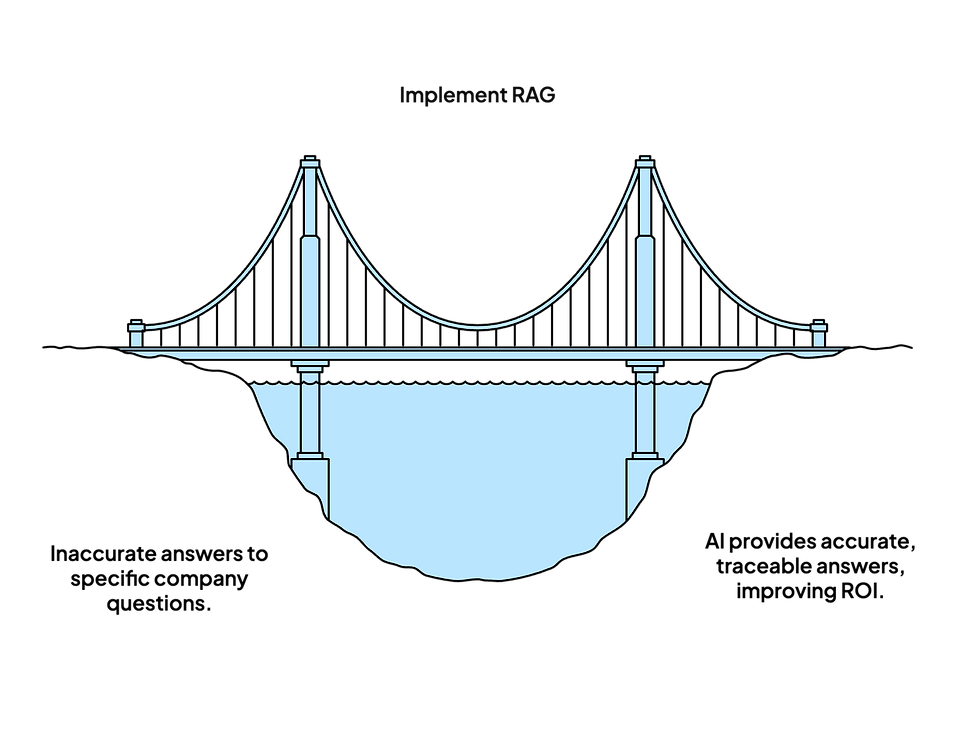The Complete Guide to Retrieval-Augmented Generation (RAG)
- Clément Schneider

- Aug 6
- 4 min read
Updated: Oct 1
You’ve probably tried ChatGPT or another large language model (LLM) like Claude, Gemini, or LLaMA. The experience can be impressive: fluent writing, creative reformulations, structured ideas.
But the moment you ask a specific question about your company — for example: “What are our product warranties for customers in Switzerland?” — the magic disappears. The AI starts guessing, loses your context, and often produces inaccurate answers.
That’s expected. Pure generative AI models are trained on a fixed dataset frozen at training time. They don’t have access to your product database, your documentation, or your internal processes. They have neither memory nor a search engine plugged into your knowledge.
Retrieval-Augmented Generation (RAG) was invented precisely to break this barrier. It’s the technology that lets an AI connect to your own data, retrieve the right information, and generate responses that are contextual, accurate, and grounded in reality.

What is RAG?
RAG is a hybrid approach that combines:
An information retrieval engine – to find the most relevant excerpts in your knowledge base.
A generative language model (LLM) – to rewrite those excerpts into a natural, contextualized answer.
Think of it as a duo:
The librarian (retrieval): knows exactly where to look in your internal documentation, FAQs, CRM, PDFs, etc.
The expert (generation): reads through these documents and synthesizes a relevant, well-structured answer.
Without the librarian, the expert “improvises” and makes mistakes. With RAG, the AI grounds every answer in verified data.
How Does RAG Work?
The process unfolds in four main steps that answer the key question many executives ask: “How does the AI really know where to search in my data?”
Step 1 — Ingestion and Vectorization
All relevant documents (web pages, product sheets, technical manuals, T&Cs, support tickets, etc.) are ingested, broken down into segments, and transformed into vectors — mathematical embeddings that capture semantic meaning. These are stored in a vector database such as Pinecone, Weaviate, or Milvus.
Step 2 — Semantic Search (Retrieval)
When a user asks a question, it is also vectorized. The system measures similarity between the query and the stored segments to identify the most relevant content, even if wordings differ.
Step 3 — Augmentation
The retrieved excerpts are injected into a structured prompt:
“Here is the user query, along with supporting documents. Use only this context to answer.”
Step 4 — Final Generation
The LLM (e.g., GPT‑5 or Claude 4) produces a fluent, coherent, and properly referenced answer. Some implementations even link back to the original documents for traceability — a must-have in fields like law, finance, or healthcare.
RAG vs. Prompting vs. Fine-Tuning
Many confuse these approaches — which is one of the most common questions executives ask.
Criterion | Prompting | Fine-tuning | RAG |
Primary Purpose | Guide output | Teach a style/jargon | Inject up-to-date business knowledge |
Dynamic Data | ❌ | ❌ | ✅ |
Source Citation | ❌ | ❌ | ✅ |
Knowledge Updates | ❌ | ❌ (retraining needed) | ✅ (just update the documents) |
Technical Complexity | Low | High | Medium–High |
Initial Cost | Very low | High | Medium–High |
In summary:
Use prompting for creativity or non-critical tasks.
Use fine-tuning to teach a stable style or domain-specific jargon.
Use RAG when precision, freshness, and traceability are essential.
Why RAG is a Strategic Advantage
Experience shows RAG is more than a technical add-on — it’s an operational performance lever with measurable business impact.
Faster Information Retrieval
Integrated into chatbots, virtual agents, or dynamic FAQs, RAG shortens resolution times and delivers contextual responses.
One global retailer saw +25% customer engagement after rolling out RAG-enabled support.
Stronger Marketing Engagement
By tapping into real-time product data, customer histories, and industry trends, RAG enables more personalized, responsive campaigns. Marketing organizations using RAG report up to +25% increases in customer engagement and conversion.
Lower Operational Costs
RAG reduces the need for costly retraining of models, cuts infrastructure consumption, and minimizes error corrections. As a result, operating costs drop significantly in knowledge-heavy environments like legal, IT, and customer support.
Top Frameworks for Deploying RAG
LangChain – The Swiss Army knife (custom builds, multi-source workflows).
LlamaIndex – Advanced indexing and multimodal support.
Haystack (Deepset) – Enterprise-ready, production-grade pipelines.
RAGFlow – Visual, plug-and-play with source citations.
Pathway – Real-time ingestion with 350+ connectors.
Best Practices
Data Quality: clean, deduplicate, and structure before ingestion .
Continuous Update: keep vector databases current with new documents.
Security: enforce access controls, align with GDPR, HIPAA, etc.
User Training: teach staff to ask effective questions and interpret sourced answers.
Future Trends in RAG
Autonomous RAG agents (self-orchestrating workflows).
Multimodal RAG (text, image, audio, IoT data).
Domain-specialized models (legal, healthcare, energy).
Federated architectures (knowledge sharing across companies without exposing raw data).
Conclusion: From Generic AI to Business Expertise
RAG closes the gap between generic LLM capabilities and your organization’s expert knowledge. By adopting it, you give your AI:
Your memory (in real time)
The ability to justify answers
A deeper understanding of your business
The impact goes far beyond technical gains: RAG transforms productivity, customer service, and marketing ROI. Most importantly, it shifts your teams’ focus from repetitive search tasks to high-value decision-making.
Adopting RAG today means preparing your organization to lead in the AI-driven economy of tomorrow.
Interested in deploying RAG for your business? Book a consultation with our team and let’s build your custom strategy.

Clément Schneider is a consultant in AI/Marketing strategy, founder of Schneider AI, and best-selling author of Get Found by AI. As a former CMO in Silicon Valley startups and a lecturer at universities like OMNES/INSEEC and CSTU, he helps organizations transform their marketing with generative AI, balancing innovation with business performance.



